Tyre law
The laws require that in order to be legal a tyre must comply with a number of legal requirements.
These requirements range from what the manufacturer must be responsible for – relevant sidewall markings etc – and what the motorist should be responsible for – correct fitment and condition of tyre, tread depths etc.
It is recommended that tyres are checked on a weekly basis for tread depth, tread condition, inflation pressure, tread/sidewall damage, any signs of irregular wear. If in doubt seek the advice of a trained tyre expert who will be able to determine the suitability of the tyre for further use.
The penalties for having illegal tyres are currently up to a £2500 fine and 3 penalty points PER TYRE!
The following gives an overview of the relevant points.
There are two important Legal Statutes that Relate to Tyres:
1. The Road Vehicles (Construction and Use) Regulations 1986.
These regulations do not cover only tyre legal requirements but any area related to road usage and traffic. They include areas related to dimensions and manoeuvrability, brakes, wheels, springs, tracks, steering, vision, instruments, fuel, minibuses, power to weight ratio, protective systems, control of emissions, plates, markings, testing and inspection and conditions related to use.
2. Motor Vehicle Tyres (Safety) Regulations 1994
Which cover the requirements relating to the supply of tyres and areas such as E markings, Part Worn tyres and Re-treads.
The Road Vehicles (Construction and Use) Regulations 1986
Regulation Number Subject Area
Regulation 24 Indicates the types of vehicle covered and also temporary use spares
Regulation 25 Details tyre loads and speed ratings
Regulation 26 Stipulates the requirements for tyre mixing
Regulation 27 Details condition and Maintenance of Tyres
Tyre Mixing
Must NOT have radial tyres on the front wheels and cross ply tyres on the rear wheels, it is also illegal to have a cross ply tyre on one side with a radial on the other.
All steerable axles must be fitted with tyres of the same construction, as must all driven axles that are not steerable. An axle includes two stub axles that form a pair, and an articulated vehicle is treated as two separate vehicles.
Unsuitability
All tyres must have a service description (i.e. load and speed index).
If the vehicle was to operate outside the service description indicated on the sidewall e.g. at a higher speed or overloaded then the tyres would be deemed to be unsuitable for the use, and a prosecution would follow.
Tyre Pressures
Regulation 27 section b states “the tyre is not so inflated as to make it fit for the use to which the motor vehicle or trailer is put”, however this statement is fairly ambiguous. As there is no indication of at what point an under or over inflated tyre becomes unfit for the use it is being put to.
Tyre Cuts
A cut in excess of 25mm or 10% of the section width of the tyre , whichever is the greater, measured in any direction on the outside of the tyre and deep enough to reach the ply or cord would deem the tyre illegal.
Ply or Cord Exposure
If there is any cut in the tyre no matter how small which exposes cords, then the tyre is illegal.
Lumps, Tears and Bulges
Regulation 27 section (d) states – ” the tyre has any lump, bulge or tear caused by separation or partial failure of its structure “.It is good practice wherever possible when assessing damage that the tyre is removed from the rim and systematically inspected both internally and externally.
Tread Depth
The legal minimum tread depth for cars and light trailers (including caravans) up to 3500 kgs gross vehicle weight and/or 8 seated passenger vehicles including driver is:
A minimum of 1.6mm in a continuous band throughout the central three-quarters of the tread width, throughout the whole of the circumference (see illustration below).
Any vehicle with a gross vehicle weight (GVW) or gross train weight (GTW) over 3500kgs or a motorcycle above 50cc must, either:
1. The grooves of the tread pattern must have a depth of a least 1 mm throughout a continuous band measuring at least three-quarters of the breadth of the tread and round the entire outer circumference of the tyre, OR
2. if the grooves of the original tread pattern of the tyre do not extend beyond three-quarters of the breadth of the tread (i.e. common with motorcycle tyres) any groove of the original pattern must have a minimum depth of at least 1 mm.
Other Points to Remember
Damage to road, person or vehicle.
If the tyre causes either damage to the road, or to persons, or to any vehicle using the road. This would cover such instances as if a vehicle with damaged or very oversized tyres which either caught against a person or other vehicle resulting in either damage or injury. Studded tyres also are included in this clause and if used in inappropriate conditions (i.e. where there is no ice or snow) and they damage the road surface then they would be clearly illegal.
Temporary Use Tyres
All tyres marked “Temporary Use Only” are restricted to 50mph.

